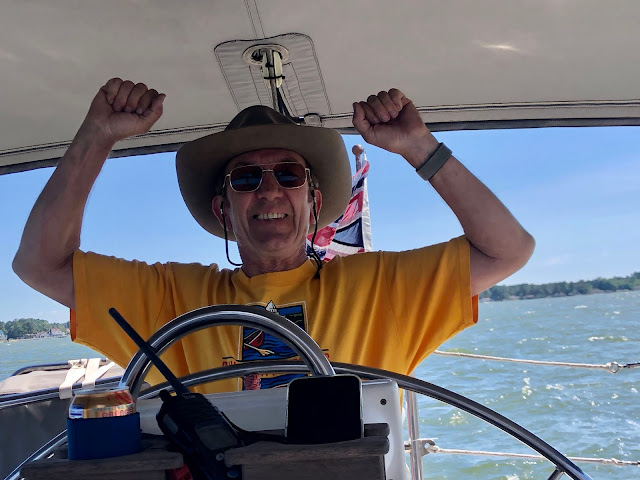Roger, the mechanic who worked on the engine was not available Thursday, June 17, so Peter climbed down into the engine room and investigated the diesel fuel leak itself. (I am happy to report that Roger, whom we liked, was not responsible.) Peter found the leak and then had to figure out, by consulting the manual, which was not very helpful, and by sheer ingenuity, how to fix the problem. The secondary fuel filter on the engine has a built-in water separator and sensor and drain; the sensor/drain was not tight. According to Peter’s assessment, Yanmar gets a F- for poor design because the sensor and drain are plastic and, to meet ABYC fire hazard requirements, Yanmar just added a metal can to cover the plastic parts so that piece of equipment can only be accessed by removing the entire filter assembly from the engine. That explains why the leak was invisible. Once again, however, Peter overcame bad design and saved the day; he’s a jack of all trades and master of many!
 |
| Peter celebrating his success at getting us out on the water |
Finally, at last, at nearly 4 p.m. we cast off from the dock at Regatta Point Yachting Center. As soon as we got into the bay, we had 13 knot winds from the northeast and were able to sail close hauled at a speed of 7 knots. We headed up the Rappahannock River, the Chesapeake’s fourth largest river, and anchored at a pleasant place on Center Creek at 6:30, surrounded by wooded banks and lovely homes partially hidden by the summer foliage. Nearby was a piling designed just for osprey nesting, and we observed the parents as well as one baby bird. There were also great blue herons in the trees and on the shore.
On Friday morning, June 18, we spent time on the boat and then took the kayak out, paddling over to The Tides Inn, an upscale resort nearby, where we had lunch and talked to staff and volunteers who were in the process of seeding a new oyster bed as part of local efforts to restore the Chesapeake Bay habitat.
We were just planning to jump up to the next northern tributary on the Rappahannock to re-anchor, which would have been a short trip, but the wind was favorable for sailing and we had no agenda, so from 3:00 to 7:00 p.m. we sailed upstream, past our destination, and then jibed and came back. We entered Corrotoman River and found a quiet anchorage on the east branch with only one other vessel anchored in sight.

Osprey nest on a channel marker 
Sherri in the pilot house as we sail on the Rappahannock
Most of the area was once an immense plantation owned by the Carter family. John Carter fled Cromwell’s regime and emigrated in 1649. In the course of his life, he was prominent in colonial government, serving one term as governor. The son of one of his five wives, Robert “King” Carter, added to his father’s holdings and when he died in 1732, he left 330,000 acres of land, 10,000 pounds in British sterling, and 1000 slaves. His descendants include three signers of the Declaration of Independence, four governors of Virginia, two U.S. presidents and Robert E. Lee. Another plantation owner along the Corrotoman River was George Washington’s grandfather, William Ball.


Glad to see that you're off and running again! Good to have a Master Mechanic onboard full-time!
ReplyDeleteHappy travels!
RodR